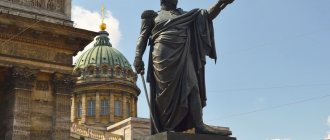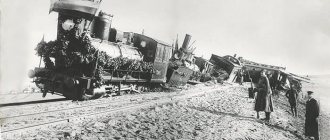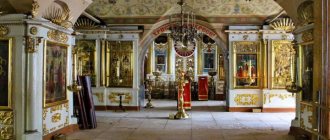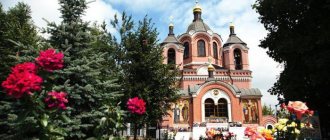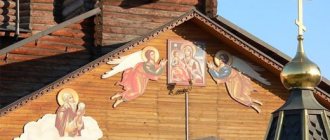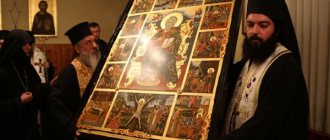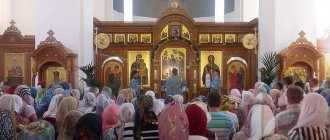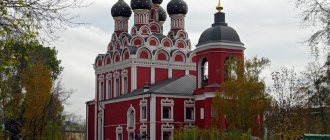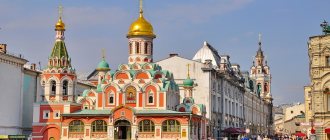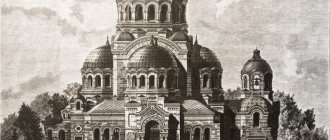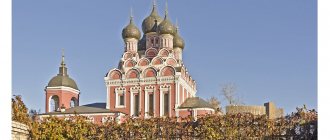The history of the famous icon
In 1579, 27 years after Russia captured the Kazan Khanate, a large fire broke out in its capital. The fire was quickly spread by the wind, and the merciless flame destroyed part of the houses in Kazan. According to the surviving legend, it was then that the ten-year-old Matrona saw the Mother of God in a dream, and she asked her to find the icon on the ashes.
The girl hastened to tell the local priest Ermolai about the dream. When the fire was excavated, an image of the Mother of God was actually found in the indicated place. Later, a new convent was rebuilt at the site of the fire, and Matrona, taking the name Mavra, became its first novice.
Several copies or copies were made of the newly acquired image. The first of them was sent as a gift to the Russian sovereign Ivan IV the Terrible in 1579. Then icons appeared in other Russian cities. Everywhere they were preserved as shrines; separate churches were built and monasteries were founded in honor of the Kazan icons. The holiday of finding an Orthodox shrine is still celebrated by believers on July 8th.
Location of the Kazan Cathedral, how to get there
The church is located on Nikolskaya street, 3 (Red Square area). The easiest way to get here is by metro (“Okhotny Ryad”, “Teatralnaya”, “Revolution Square”, “Borovitskaya”, “Lenin Library”, “Arbatskaya”, “Alexandrovsky Garden”).
Visitors arriving by car can use the nearest parking lot, located near Okhotny Ryad and GUM.
You can get to the church daily from 9 am until the end of the evening service. It starts at 17:00. On Sundays and holidays, the liturgy takes place at 7 and 10 am. On ordinary days it is at 9 o'clock. Every Friday after Vespers there is a prayer service with the blessing of water and akathist of the Kazan Cathedral in Moscow. The church holiday dedicated to the icon takes place twice a year: November 4 (the day of the liberation of Moscow from Polish invaders) and July 21 (the discovery of the shrine on July 8, 1579).
History of construction
A historical guide to the city, published at the end of the 18th century, reported that the first temple erected in honor of the revered icon appeared near the Kremlin in 1625. It was built from wood with the money of Dmitry Mikhailovich Pozharsky.
View of the cathedral from Red Square
It is known that during the second people’s militia, formed in 1611, Pozharsky did not part with the list made from the famous icon. After the victory over the Polish-Lithuanian invaders and the liberation of the capital, he kept the treasured image in his parish church on Lubyanka. The new wooden cathedral was built by the prince specifically for the Kazan Icon. However, the church stood for only 9 years and burned down in a fire.
The place near Red Square was empty for long. Already in 1636, Tsar Mikhail Fedorovich allocated money, and a new stone temple was erected near the Moscow Kremlin.
As was customary in church architecture, at the beginning of the 17th century, the bell tower was added to the northwest of the church building. The new church immediately acquired a high status, because it was consecrated by Moscow Patriarch Joasaph I himself.
Attraction rating
Many believers strive to visit the Cathedral, despite the fact that in terms of its size and richness of paintings it is inferior to other architectural masterpieces of the city. Despite this, its rating, for example, given on the TripAdvisor website, is 89th out of 2799. The temple is popular among residents and guests of the city. This is explained by the unusual state of mind of a person captured by the quiet, peaceful atmosphere of the church. It really protects a person from troubles and serious problems. This is the “shield and sword” of the Christian world, born of its unusual history.
History of the temple in the 17th-20th centuries
In 1647, a chapel dedicated to Saints Gurias and Barsanuphius was added to the Kazan Cathedral. The solemn ceremony of its consecration was attended by the son and successor of Mikhail Fedorovich - Russian sovereign Alexei Mikhailovich.
Despite the fact that the temple was small, it always played a large role in the spiritual life of the city. The Kazan Cathedral was revered along with the most famous churches in Moscow, and its rector was highly respected among the Moscow clergy.
Time passed, and in the 60s of the 18th century, at the expense of Princess M.A. Dolgorukova, the Kazan Cathedral was reconstructed. The dilapidated chapel was demolished, and around the bell tower many shops appeared, selling wax candles, apples and ruddy rolls. For a long time, Moscow merchants were sworn in in the stone church.
View of the cathedral from the State Historical Museum
Over time, the nearby Upper Trading Rows became so disorganized that they practically blocked the view of the temple from the Kremlin. At the very beginning of the 19th century, the tented bell tower was dismantled and a two-tier belfry was erected in its place according to a new model.
Like all of Moscow, the Kazan Cathedral underwent many trials during the invasion of French troops in 1812. Just before the arrival of enemies near the temple, Muscovites willingly bought popular prints and caricatures of the French and Napoleon himself. To prevent the enemy from getting the revered icon, the priest of the temple hid it in advance. However, when French troops entered the city, they did not fail to mock the Orthodox church. The soldiers threw the throne out of the altar and dragged the horse's corpse inside the church.
Another large-scale renovation of the cathedral was carried out in 1865. Architect Nikolai Ivanovich Kozlovsky prepared the project, the temple facades were rebuilt in classical traditions, and another tier was added to the bell tower. It is noteworthy that both parishioners and priests greatly regretted such changes. After reconstruction, the Kazan Cathedral lost its original appearance and became similar to many rural churches that stood in different parts of the country.
With the advent of Soviet power, church life changed. Divine services in the cathedral were not immediately banned. In the summer of 1918, Patriarch Tikhon, who preached here, told parishioners that the royal family had been shot by the Bolsheviks. And in the fall of the same year, the most priceless temple shrine, the famous Kazan Icon, disappeared without a trace.
View of the cathedral from the southeast and the Averkievsky chapel
In the mid-1920s, the famous restorer Pyotr Dmitrievich Baranovsky began a major restoration of the building. The work lasted for several years, as restorers tried to return the cathedral to its historical appearance. By 1929, they managed to decorate the walls and recreate the rows of ancient keel-shaped kokoshniks, but the unexpected happened. Baranovsky learned that the Moscow leadership had decided to demolish the cathedral. The Moscow authorities wanted to hold physical training parades and demonstrations of workers on Red Square and therefore did not want to see a single religious building nearby.
The architect was very upset, but managed to take careful measurements of all the architectural parts of the temple. The documents he compiled were used several decades later, during the restoration of the cathedral. In the early 1930s, services in the cathedral were banned. First, a canteen was opened inside the former church building, and then a marble warehouse was created, which was used for the construction of the Moscow metro.
In 1936, the cathedral was destroyed to the ground, and in its place a pavilion rose, built according to the design of Boris Mikhailovich Iofan.
Then a summer cafe was built here, then the area was decorated with marble and a fountain was installed in the middle. After all this, a public toilet was built on the site of the Orthodox church.
Current state of the cathedral
Figure 3. Kazan Cathedral at night
Now the cathedral is actively functioning. You can order a wedding or prayer service there, pray to the Mother of God, or simply honor the shrine while walking past it to the Kremlin.
Prayer of thanksgiving to the Mother of God
Architecture and decoration of the cathedral
The Kazan Cathedral is a pillarless, single-domed temple with a pile of kokoshniks, typical of the first half of the 17th century. It is surrounded on three sides by open galleries that lead to a hipped bell tower at the north-west corner.
What's inside
Inside there are two chapels, high ceilings, the smell of incense - the classic decoration of an Orthodox church.
Iconostasis
On March 17, 1922, the old iconostasis of the cathedral was dismantled - it was made of gold and silver. All the jewelry was sold.
Now it has been restored, where possible, with the original icons, and where not, with lists of them. It contains images of the Trinity, holy saints and, traditionally, archangels.
Shrines and relics
The cathedral contains two miraculous icons - the Moscow list of Kazan (a copy of the one that was stolen) and the “Education”, as well as a reliquary with particles of the relics of 83 saints, which more than once showed good signs.
Revival of the temple
The initiative to recreate the ancient temple was taken by employees of the city monuments protection society. Construction began in 1990 and took three years. The cathedral near the Kremlin became the first church in the territory of the former USSR to be restored to its historical form.
Cathedral dome and mosaic of the Kazan Mother of God
It is noteworthy that all work was carried out under the guidance of the talented architect Oleg Igorevich Zhurin, who studied with P. D. Baranovsky. The builders were lucky because old records, drawings and photographs of the cathedral were preserved. It was not possible to find photos of the wall paintings, so professional painters from Bryansk and Palekh painted the temple in the traditions of the 19th century.
The opening of the revived shrine was timed to coincide with the beginning of November. And now this temple is considered a symbol of the liberation of the capital from Polish-Lithuanian troops.
Architecture, interior decoration
The cathedral is made in the style of a single-pillar temple. It is surrounded by rows of bright kokoshniks, creating a solemn, elegant look. On the north-eastern side there is a chapel dedicated to Averky of Hierapolis. On the northwestern side there is a hipped bell tower. This was the custom in the construction of churches in Rus' at the beginning of the 17th century. All buildings form a beautiful, harmonious complex that adorns the ensemble of Red Square.
Not a single ancient relic or image of the church’s interior has survived. The restoration of the paintings took place after a careful study of the descriptions found in the documents. This work was carried out by masters of church paintings from Bryansk and Palekh. The interior walls and ceiling of the church are decorated with floral patterns and frescoes. The scenes depicted with their help tell the story of the acquisition of the icon and the events associated with its participation.
Short description
The temple was built in honor of the Kazan miraculous icon of the Mother of God, which is its most important shrine. The author of the project adhered to the Empire style of architecture, imitating the churches of the Roman Empire. It is not surprising that the entrance to the Kazan Cathedral is decorated with a beautiful colonnade, designed in the form of a semicircle.
The building stretches 72.5 m from West to East and 57 m from North to South. It is crowned with a dome located at a height of 71.6 m above the ground. This ensemble is complemented by numerous pilasters and sculptures. From Nevsky Prospekt you are greeted by sculptures of Alexander Nevsky, St. Vladimir, Andrew the First-Called and John the Baptist. Directly above their heads are bas-reliefs depicting scenes from the life of the Mother of God.
On the facade of the temple there are six-column porticoes with a bas-relief of the “All-Seeing Eye”, which are decorated with triangular pediments. The entire upper part is decorated with a voluminous attic. The shape of the building itself copies the shape of the Latin cross. Massive cornices complement the overall picture.
The main room of the cathedral is divided into three naves (corridors) - side and central. In shape it resembles a Roman basilica. The partitions are massive granite columns. The ceiling height is more than 10 m, they are decorated with rosettes. To create believability, alabaster was used in the work. The floor is paved with gray-pink marble in the form of a mosaic. The pulpit and altar in the Kazan Cathedral have areas with quartzite.
The cathedral houses the tombstone of the famous commander Kutuzov. It is surrounded by a lattice designed by the same architect Voronikhin. There are also keys to the cities that fell under it, marshal's batons and various trophies.
The fate of the cathedral in Soviet times
In 1925, restoration work began in the temple under the initiative of the architect Baranovsky. In the course of them, he found out that the walls of the ancient temple were well preserved. Baranovsky wanted to restore the original appearance of the monument.
But this was not destined to come true. The disappearance of the miraculous image became a terrible sign that foreshadowed the death of the cathedral 300 years after its construction. In 1919, the building was inspected, on the basis of which a decision was made to demolish it. The Soviet government, which came to power, considered that the monument did not fit into the general ensemble of Red Square as a venue for mass socialist events. The temple was destroyed in 1936.
Before the demolition of the building, Baranovsky managed to take photographs and measurements of it. It is these sources that will later be used to restore the monument.
Shrines
The Temple contains the following shrines:
1. Revered Icon of the Kazan Mother of God. From the point of view of iconography, she belongs to the Hodegetria type. Its prototype was kept in Constantinople. The Virgin Mary holds the baby Jesus Christ in her hands, bowing her head. The baby is depicted from the front. One hand is hidden by clothes. The gaze of the baby and the Mother of God is turned to the praying person.
2. Icon “Education”. Before the revolution, the original icon was kept in the temple. Now here is her exact list. It depicts the Mother of God holding a baby in her left hand. They pray in front of the icon, asking for help in raising children in faith and piety.
A visit to the Kazan Cathedral in Moscow will fill your soul with peace of mind and confidence in protection from worldly troubles.
